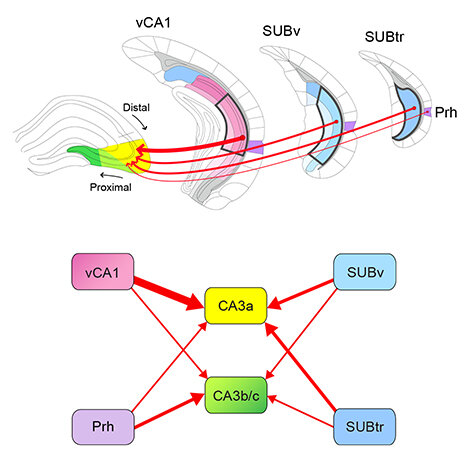
A research team led by University of California, Irvine has discovered new neural circuits that regulate spatial learning and memory in the brain’s hippocampal formation. The team identified novel functional roles of new circuit connections between the venal CA1 region and dorsal CA3 regions of the hippocampus and demonstrated that genetic inactivation of this projection impairs object-related spatial learning and memory, but does not modulate anxiety-related behaviors.
The study, titled “Non-canonical projections to the hippocampal CA3 regulate spatial learning and memory by modulating the feedforward hippocampal trisynaptic pathway,” was published today in PLOS Biology.
The hippocampus is not a homogenous brain area. The septotemporal axis, along which the trisynaptic pathway is located, separates the dorsal region of the hippocampus, which is more involved in learning, memory and spatial navigation, and the ventral region, which plays a role in emotional behavior. The trisynaptic’s feedforward, unidirectional circuit organization is well documented, but the connectivity across septal to temporal regions is less well described.
“Our findings extend the knowledge of hippocampal connectivity and its relation to learning and memory processes across the septotemporal axis and provide a circuit foundation to explore these novel functional roles,” said Xiangmin Xu, Ph.D., Chancellor’s Fellow and professor of anatomy and neurobiology, and director for the Center for Neural Circuit Mapping (CNCM) at the UCI School of Medicine. “The new hippocampal circuit mechanism is highly relevant to treating learning and memory disorders, including Alzheimer’s disease.”
Building on their earlier work, Xu and his team used multiple viral tracers, including monosynaptic rabies retrograde tracing and herpes (H129)-based anterograde tracing to establish new hippocampal CA1 projections to CA3. Robust mapping results showed that CA1 inputs to CA3 run opposite the trisynaptic pathway and in a temporal to septal direction. They also found that genetic inactivation of the CA1 to CA3 projection impaired object-related spatial learning and memory, but did not modulate anxiety-related behaviors.
Source: Read Full Article
